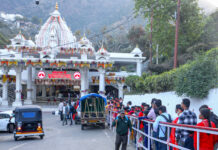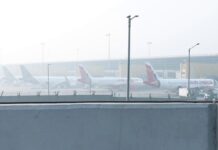NEW DELHI: Four resorts, tree houses and tourism tents with 460 rooms will be set up in the Andaman and Nicobar Islands, known for its world-class beaches with pristine water and shallow reefs, officials have said.
Aiming to make the archipelago a major tourist attraction like the Maldives and Mauritius, bids are invited from private players to develop tourists facilities under design, build, finance, operate and transfer on public private partnership (PPP) basis.
According to the plans, an eco-tourism resort with 220 rooms will be set up at Lalaji Bay, Long Island. Eco-tourism tents and tree houses with 70 rooms will be set up at Smith Island, similar tents with 50 rooms will be set up in Aves Island and an eco-tourism resort with 120 rooms will be set up at Shaheed Dweep (Neil Island).
These four PPP projects are part of the Central government’s ambitious plans for the all-round development of the Andamans, a Home Ministry official said.
The plans include setting up premium tents and tree houses, mangrove interpretation center, turtle observatory center, island hopping facility, beach shacks and sunrise points, premium island resorts, beach promenade, nature trail and camping facility besides other infrastructure.
All planned projects are expected to bring in investment of more than Rs 650 crore and have in-built condition of 60 per cent local employment, the official said.
The Andaman and Nicobar Islands is renowned across the world for its pristine natural beauty, rich marine life, flora and fauna spread over 836 islands, islets and rocks. The islands present picturesque views with rich culture and heritage.
“The pristine water with world-class beaches and shallow reefs are a major attraction for tourists. Our aim is to make the Andamans an attractive world-class tourist destination similar to the Maldives and Mauritius,” the official said.
Paving the way for ‘Ease of Tourism’, 30 islands have already been exempted from the Restricted Area Permit (RAP) regime and requirement of mandatory registration of foreigners arriving in the archipelago within 24 hours of their entry has also been done away with.
The water-sport industry has been given a big boost and the regulations and guidelines have been simplified, duly considering the safety aspect of users while honouring operator’s interest.
The islands have witnessed an increase in the number of licensed diving centers, whereas adventure products like sea walk and para-sailing have been newly introduced.
The bed-and-breakfast scheme has enrolled 40 home stays, 121 tour operators have been registered since 2014 and a state-of-the-art sound and light show facility has been installed at Netaji Subhash Chandra Bose Island (Ross Island).
Floating jetties have been installed at various tourism islands and orchid, butterfly gardens are being developed to attract nature lovers.
During 2014-18, tourist arrivals have increased from 3.11 lakh to 5.13 lakh, a growth of 65 per cent. Hotel accommodation has doubled and now stands at 7,000, while more than 100 small size fiber-reinforced plastic (FRP) tourist boats and 1,000 tourist cabs have been added over the period.
A total of 94 per cent area in the Andamans comprises rich forests and mangroves that house endemic birds, wildlife and tropical rain forest. “Tourism has emerged as the primary economic growth driver for the islands after careful deliberation on their social fabric, environment sensibilities and development potential,” another official said.
According to the data available with the Ministry of Home Affairs, more than 16 lakh tourists have visited the Andaman and Nicobar Islands between 2015 till 2018. The archipelago has received about 5.13 lakh tourists, including over 20,000 foreigners in 2018, while 487,229 tourists, including 15,310 foreigners, visited it in 2017.
In 2016, as many as 400,019 tourists, including 15,467 foreigners, visited the islands and in the previous year, 311,358 tourists, including 14,674 foreigners, had visited it. The Andaman and Nicobar Islands comes under the administrative control of the Ministry of Home Affairs.
The archipelago has been inhabited for several thousand years, at the very least with archaeological evidence going back to some 2,200 years.
However, indications from genetic, cultural and linguistic isolation studies point to habitation going back 30,000 to 60,000 years, well into the middle palaeolithic, according to the Andaman and Nicobar Islands Tourism Department. PTI







